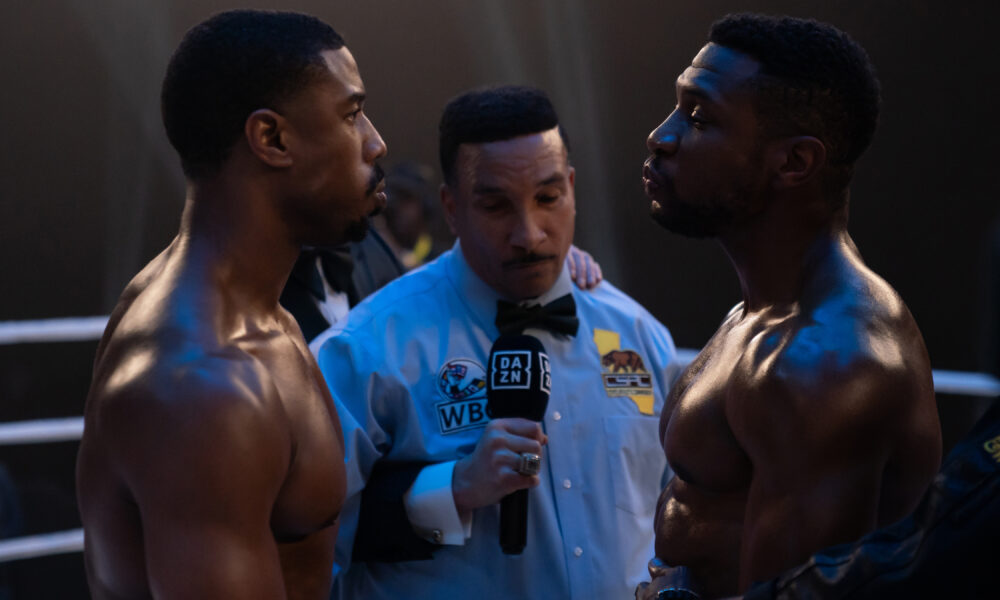I never really understood why directors were called storytellers until I watched the first Creed film. Somewhere between the gut-wrenching words of Meek Mill, Adonis’s (Michael B. Jordan) fingers tangled in Bianca’s (Tessa Thompson) braids, and the sweat, blood, and tears hitting the floor, I was completely transported. Watching the film felt like director Ryan Coogler was sitting in front of me, pulling me to the edge of my seat with everything he found beautiful in life. The second movie had a similarly enchanting feel, so I was more than intrigued (and I’ll admit, a little concerned) to hear that the third Creed film (the ninth installment in the Rocky franchise) would be helmed by a new director: The film’s star, Michael B. Jordan.
The movie picks up with world heavyweight boxing champion Adonis Creed three years into his retirement, still waiting to find his rhythm outside of the ring. He doesn’t know what to do with himself—he still has a little bit of the competitive bug and a whole lot of anger. Add in an uncomfortable surprise from his past, a battle to confront his own emotions, and a challenge he can’t back away from and––well, you might as well just cue a fierce training sequence set to J. Cole and Kehlani.
I’m Nervous, I’m Excited, but I’m Nervous
Creed III felt kind of…fast? At first, viewers are introduced to characters in scenes set with a kind of pump-fake conflict to make the real conflict that much more intense. I’ll admit, it worked; but once the main conflict was established, it felt like we rushed right through solving it. I mean, had my 10 p.m. bedtime alarm not gone off in the middle of the theatre, I would have mistaken the final fight for only more build-up. The movie’s run-time was just under two hours, but had they drawn out the big confessions or let those side-by-side training scenes run just a tad longer, the ending would have been a real knockout—pun intended.
Mental Health Matters
Looming even larger than I-can’t-look-away-from-the-tank-that-is-Jonathan Majors was the theme of pain and buried emotions. The entire film seems to ask, “how do you just talk about it?” The Rocky franchise included the overarching theme of “you vs. you,” which Creed III seems to pick up and shine its own light upon.
One Time for the Girliesssss
Going against the conventions of sports films, there were women in this film: Not just at parties, or signalling the changes between rounds, but in the sparring rings, holding up the pads and pushing champions to their limits. They stood, immovable, in the way of plans to just bottle pain up and try to forget it. Most of all, they were there, waiting at the end of a long line of legends, confident and ready to become the next one.
Can You Hear Me Now?
On the note of representation, the film also invited hearing viewers into the deaf community through Amara (Mila Davis-Kent), the daughter of Adonis and Bianca. It cleanly cuts through the stigma often associated with deaf people by presenting her not as an afterthought, but as a complex character with her own subplot. The film said, “here is Amara, she’s deaf… what about it?” In one scene that stuck with me, Adonis and Bianca were teaching a houseguest two American Sign Language phrases so that they could greet the young girl. In a way, they were teaching the audience, too, and lowering that barrier of entry.
Like with Coogler’s entries, the movie felt like an invitation into Jordan’s mind. The struggles highlighted and people given voices throughout the film felt like a beautiful, genuine glimpse at how he sees the world. Boxing fans, movie buffs, and MBJ fans alike will be delighted by the delivery of such a potent message through the knockout movies we all love.








